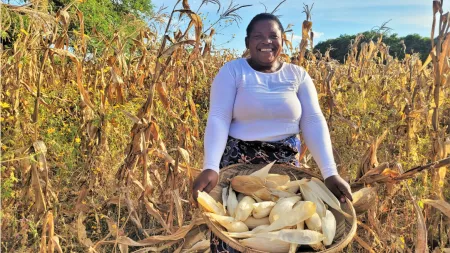Buumba Chilimba, 45, mother of seven, is a small-scale farmer in southern Zambia who has been struggling with the extreme weather events caused by climate change. “In the last three crop seasons beginning in 2018/2019, I hardly had any crops on my fields, harvesting nothing,” says Buumba, as the severe droughts, heavy rains, or flash floods make it difficult to grow vegetables, maize, and grain.
Small-scale farmers represent the vast majority (approximately 90 percent) of Zambia’s agricultural producers, while 59 percent of Zambia’s population is employed in agriculture. This makes it the main source of income for most Zambians.

In Zambia, drought is a recurrent problem. The droughts in 1990/91, 1996/96, 2019/20, and 2021/22 have especially damaged agriculture and affected millions of people due to crop failures, food, and water shortages, livestock deaths, and reduced GDP. Droughts are also a challenge for Buumba and her maize fields.
A growing maize plant requires about 2-3 liters of water per day during the peak growing season. Dry spells lead to reduced crop yields. “In the last couple of years, it has become worse. It gets hotter and rain has become unpredictable. It’s either too dry or too wet, we hardly have normal weather anymore,” says Buumba.

On the other hand, flash floods have increased in severity and frequency in recent decades. Flash floods are floods that begin within three to six hours due to extremely heavy rainfall. In Buumba’s home district, it often does not even rain, but a dam break or river overflow in a different region causes her home to flood. Between the years of 1980 and 2020, Zambia experienced 21 floods affecting many hundreds of thousands of people.
Most recently, at the beginning of 2023 a flood displaced more than 4,000 people in Buumba’s district alone. She is lucky that her house was not damaged, but her fields were under water and there was little left for her to salvage. “The water came so quickly and caught us off-guard,” remembers Buumba. A 2022 study shows that only four to six days of flooding reduces maize grain yields by 21 to 35 percent. Adding the stress of flash floods it can destroy the plants either through heavy water flow or debris that is carried with the water.

Buumba has received seeds of the more stress-tolerant orange maize from CARE. “This is the only crop that survived the floods. The normal white maize plants were destroyed by the floods,” says Buumba. The orange maize is also rich in vitamin A, giving essential nutrients to the family’s daily consumption and boosting their immune system. “It even tastes a little bit better than the usual maize we use,” she says laughing.
In Zambia, more than half of the children under five are Vitamin A-deficient. Adding pregnant women who are also vulnerable to Vitamin A-deficiency, this contributes to high rates of infection and poor pregnancy outcomes, and is also an underlying cause of stunting in children. “When we went out to the fields to inspect the damage, we were very surprised but also happy that the orange maize was still standing and we could harvest it,” says Buumba.

With maize, families in Zambia can cook the traditional nshima, a type of polenta, which is Zambia’s staple food. “We use the harvest for our meals. With the crops that I have now, we will be able to have three meals a day for the next two months,” concludes Buumba happily.
